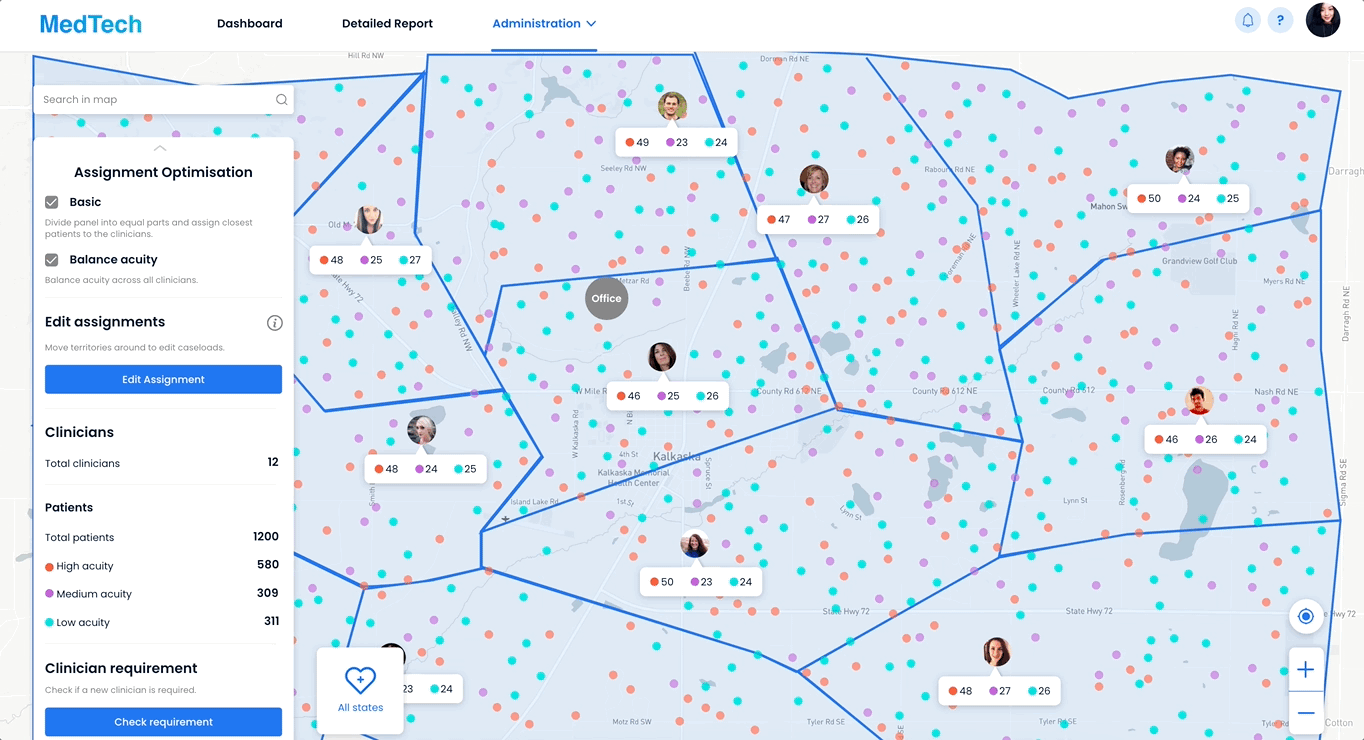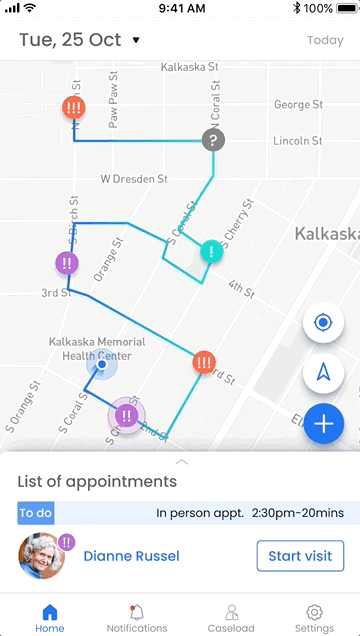MedTech
Enabling nurses and managers to optimally deliver healthcare
Overview
MedTech* MVP streamlines home healthcare delivery in the US by providing nurses real-time notifications of patient admissions and transfers, while reducing administrative workload and travel time for healthcare teams
* Name of the application is changed
At a glance
Responsibilities as product designer
Worked with
Codewalla
Design management
design sprint &
deliverables planning
Year & timeline
2021, 6 months
UX analysis
user flows, persona &
information architecture
Team
4 engineers, 1 designer
Prototyping
brainstorming, wire-framing & UI design, prototyping
User story, behind the research
The below cards are an example of ineffective Transitions of Care (a process of transferring a patient’s care from one setting or level of care to another). These transitions are particularly vulnerable points in the healthcare continuum.
Simon, 72, returns home post-cardiac arrest procedure. After a week in the hospital, he faces the challenging transition to home care with multiple new health requirements.
He is given many medications and a detailed schedule, but he gets confused. The complexity of taking five different medications at various times throughout the day becomes overwhelming, putting his recovery at risk.
A week later, Simon is readmitted to the hospital. His medication mismanagement led to complications that could have been prevented with proper home healthcare coordination.
Research analysis
-
Research revealed Medicare Transition of Care patients as the most underserved segment in home healthcare, struggling with care coordination and follow-up services. This insight guided MedTech's initial phase to focus specifically on streamlining TOC patient care management
-
The nurses have to schedule visits with the patients at specific intervals according to the severity of their health.
-
The visits nurses or their care managers schedule and their outcome, have to be well documented for audit purposes and financial purposes.
Pain points of nurses
-
A nurse spends hours on paperwork and administrative tasks instead of patient care. They must manually document visits, track medication schedules, and update patient records across different systems. This documentation overload often extends their workday and reduces time spent with patients who need direct care.
-
Nurses waste significant time driving between patient locations without optimal routing. They often receive last-minute schedule changes or urgent patient needs that disrupt their planned routes. During coverage periods, they must manage additional caseloads in unfamiliar geographic areas, leading to more travel inefficiencies.
-
When visiting patients, care managers lack immediate access to critical updates like recent hospital admissions or discharges. They must manually track patient acuity levels and service requirements, often discovering important changes only after arriving at a patient's home. This creates gaps in care delivery and reduces their ability to respond promptly to emerging patient needs.
Pain points of managers
-
Managers struggle to integrate information from multiple sources - hospitals, clinics, and home care visits. They lack a unified system to track patient journeys, leading to incomplete visibility of care delivery. This fragmentation makes it difficult to make informed decisions about resource allocation and service quality improvements.
-
Without real-time tracking capabilities, managers cannot effectively monitor care manager compliance or optimize caseload distribution. They face difficulties in matching the right care manager to patient needs based on location, expertise, and availability. This results in underutilized staff in some areas while others are overburdened.
-
Managers lack tools to accurately track service delivery metrics and reimbursement data. They struggle to prevent hospital readmissions due to delayed response to patient deterioration. The inability to audit care quality in real-time leads to increased operational costs and reduced healthcare outcomes.
Business goals
-
Concept validation
Align with the founder's vision and validate the concept through market testing and user feedback. This in turn will attract investors.
-
Position for scaling
The design should incorporate a flexible, design so that it can be scaled up by adding features without compromising the core functionality.
-
MVP + Vision strategy
The design should balance core features that streamline nurses' daily workflows, while select innovative elements that demonstrate the vision.
Based on the research and the pain points, I came up with the opportunity statement
How might we streamline the care management process for nurses and managers handling Medicare transition patients, so they can focus on patient care while meeting compliance and documentation needs?
Introducing
Medtech
A dual-interface solution, nurses access smart scheduling and easy documentation, while managers control workload distribution and performance tracking - reducing paperwork and simplifying team management.
A user friendly and scalable web application for managers to upload, assign, supervise the nurses and their patients.
Performance tracking dashboard
Managers can track the services, nurses provided to their patients, high performing nurses and track patient readmissions. I also provided a Configure option as a concept for phase 2.
Extensive documentation
One of the major tasks for managers is to keep a track of the patients and clinicians records. The tables are extremely detailed, with CRUD operations and filters.
Assigning patients
I designed a concept for assignment optimisation, which takes in variables like acuity, location(nurse and patients), nurse’s experience and automatically assigns patients to nurses. This was highly appreciated by the clients and the users.
*This was a vision design, and was not developed
A user friendly and scalable mobile application for nurses to increase their productivity and reduce their efforts in administrative tasks.
Viewing schedules in calendar and map
The nurses, have to consider the location, and time slots while scheduling, so I provided the map as the home-screen with the calendar view available on a swipe. This will help the nurses quickly view their schedule.
Appointment slots recommendations
I provided appt. slot recommendations as we had access to the nurse’s schedule, we also kept the location and travel time into consideration when displaying
the recommendations.
Documentation on the go
While the nurse is visiting the patient, I provided a timer, as it will help them in their audits. Also I provided a quick form, which she can fill with key points when she is done with the appt. She can then fill it out in detail when she reaches office.
User testing
The columns in manager platform were arranged and rearranged according to the feedback I received.
Certain states, like COVID and HBCS were introduced, after testing.
Terms like “Documentation” were changed to Med Review in nurse platform.
“This is phenomenal! In all my years of delivering care to homes, I've never seen anything like it!.”
-BSN
What I learned?
Collaborating with clients and managing their expectations on a regular basis is very important in MVPs, to stay aligned with their vision.
I was working in an agile environment, so I learned a lot about managing my work for design sprints.












